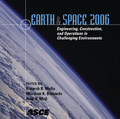Human Assistant Planetary Exploration Robots
Publication: Earth & Space 2006: Engineering, Construction, and Operations in Challenging Environment
Abstract
Humans have dreamed of exploring Mars for many years. However, the recent mandate by President Bush directing NASA to send humans to Mars (after first returning to the moon) has transformed the work in planetary exploration from the realm of paper studies and theory back into the realm of a near-term reality [4]. As humans prepare to venture out of low Earth orbit, robots will be integral teammates in this endeavor, if for no other reason than size of the area to be explored. The moon has a surface area approximately the size of the continents of North and South America combined, and Mars has a surface area approximately the size of the entire land mass of Earth. Because of the shear scale of this exploration area (and the limited number of humans who will be able to visit on any given mission), robots will be involved in any realistic exploration scenario. Many of these robots will operate on their own (or with other robots) and never work alongside humans. However, other robots (akin to the lunar rovers used during the later Apollo missions) will be specifically designed to assist humans and maximize their effectiveness during Extravehicular Activities (EVAs). These robots will afford the astronauts the mobility to explore much larger areas of the surface than they would be able to reach on their own, allow them to transport scientific equipment, and provide task assistance at several levels. Commands sent from Earth cannot travel faster than the speed of light, and data/images from the robots are also subject to this limit. This intergalactic speed limit leads to minimum round trip signal delays between Earth and the moon of about 2.5 sec, and for Mars the time varies from about 8 to 42 minutes, depending on the planetary alignment. Because of these delays, robots will be most effective if they primarily receive high level commands and goals from Earth. Deploying robots capable of accepting high level commands will require them to be more self-sufficient (and self-monitoring) so that they can work autonomously to achieve those high level goals. Designing these autonomous mobile robots will require careful planning and utilize a wide range of engineering and scientific disciplines/technologies which are currently in various stages of maturity. All robots intended to be used as human assistants will need to be designed to maximize the effectiveness of EVAs. Furthermore, these robots must be "safe" around the astronauts, so they do not increase the net risk involved in planetary exploration. The robots will help maximize EVA effectiveness by providing combinations of: increased EVA exploration range, increased EVA duration, increased payload capability, and increased situational awareness. These human-assistant robots must also be designed to minimize the overhead (repairs, maintenance, "boot time", etc) associated with their operation, so that they are truly providing assistance (and not a net hindrance) to the astronauts. This paper attempts to describe the robots most likely to be deployed as human assistant robots over the next 15 years to help support lunar surface exploration as a precursor to missions to Mars.
Get full access to this chapter
View all available purchase options and get full access to this chapter.
Information & Authors
Information
Published In
Copyright
© 2006 American Society of Civil Engineers.
History
Published online: Apr 26, 2012
Authors
Metrics & Citations
Metrics
Citations
Download citation
If you have the appropriate software installed, you can download article citation data to the citation manager of your choice. Simply select your manager software from the list below and click Download.
